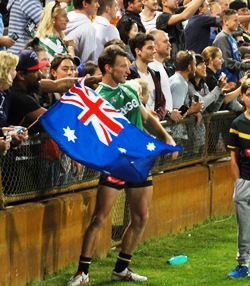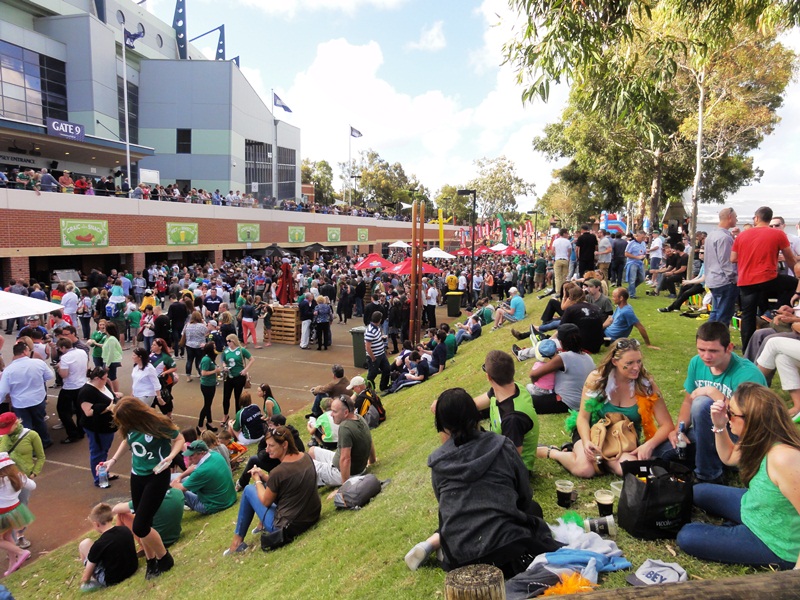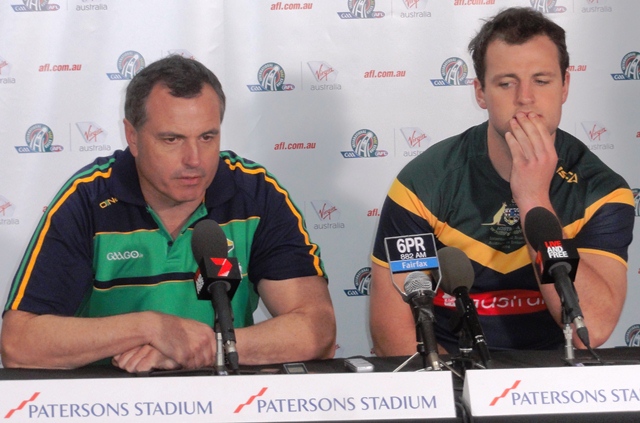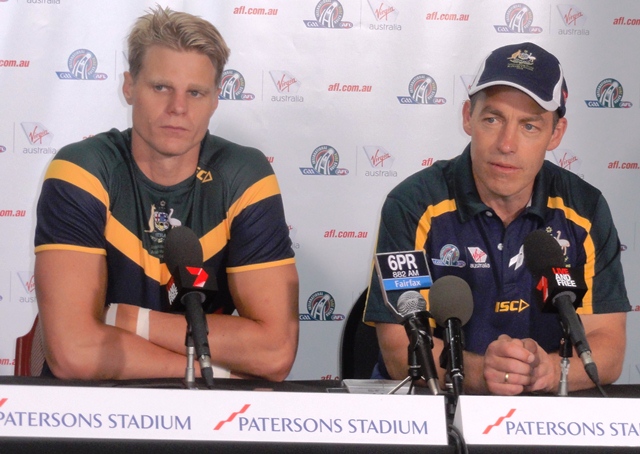Calls for a second Test as Australia’s skill surprises Ireland
- Sunday, November 23 2014 @ 03:38 pm ACDT
- Contributed by: Harley Vague
- Views: 3,287

 Australia won the Cormac Mc Anallen Trophy in front of a sellout Patterson’s Oval by a 10 point margin. It was a welcome and highly successful return to International Rules football in Perth leading to unanimous calls for the competition to return to a two game series. Both the Australian and Irish contingent suggested it would be more satisfying and also fairer on the visiting team. Calls for the game to be taken to New York and Boston were greeted with enthusiasm by the Aussies but with less enthusiasm by the Irish.
Australia won the Cormac Mc Anallen Trophy in front of a sellout Patterson’s Oval by a 10 point margin. It was a welcome and highly successful return to International Rules football in Perth leading to unanimous calls for the competition to return to a two game series. Both the Australian and Irish contingent suggested it would be more satisfying and also fairer on the visiting team. Calls for the game to be taken to New York and Boston were greeted with enthusiasm by the Aussies but with less enthusiasm by the Irish.
The game had all the trappings associated with an international contest. On a somewhat balmy evening the towering lights of Subiaco highlighted the colour of the twilight game. Many Aussies joined the Irish fans in the pre-game buildup to provide a party atmosphere perhaps primed by the Irish Festival outside the ground. It was a complete success judging by the length of the queues for food and drink. The large crowd outside the ground streamed in late oblivious to the band Pseudo Echo playing inside.
An observer might have been confused as to who was who. It was the Aussies that played skilful Gaelic-style football and kicked accurately whilst the Irish were unaccustomly off-target. This may at firstl be attributed to nerves but later, the scoreboard pressure caused the Irish team to panic a little and rush their shots. Sometimes they were undecided as to go for an Over or push for a netted goal. Like the combined rules of the game, Australia combined well under the combined colours of Australia Blue, Green and Gold.
It was the Irish who had to chip away at the large Australian lead and mount a late charge. It was noticeable that both teams were very comfortable with the rules, not only their applications but their implications. Some Australians soloed(kicked the ball to themselves) so as not to infringe by using more than two bounces or soccered the ball to rebound off of an opponent to draw a boundary free kick. The statistics showed that the Irish layed more tackles.and they generally outmarked the Aussies. They somewhat surprisingly consistently marking the Australian kick-in but not their own kickin..
It is unnecessary to go into the history of the hybrid game but suffice to say most people saw this game as a last ditch effort to revive the series. I see it as the first step in re-establishing competition. Pedantic maybe. The AFL has deemed playing criteria for their team as being All-Australian selection. This will certainly please football fans of both countries even though this limits the opportunity for Australia to choose the best possible team to win. There is no need for ruckmen or even talls in the hybrid game. To compensate the rules have been tweaked again requiring a long kick-in which provides a chance for some aerial contest. The WAFL has come to the party, literally, by arranging an Irish festival in the shadows of Patterson’s Stadium starting at 2pm undoubtedly in response the party atmosphere that has surrounded previous Perth Tests. Looking ahead, the AFL has suggested it might follow much earlier musings and take the series to the Irish immigrant strongholds in N.E. U.S.A.
Between 1820 and 1860, Half the population of Ireland, one million people emigrated to America disembarking in New York. A New York game would be of great promotional value to both codes as well as taking the series to three games which would give a result on games won not aggregate score which has been the case in the previous two game series. Taking the series to the U.S.A. would mean retaining the heavy Gaelic influences. The appearance of the game is totally Irish and most importantly the ball is round.
The Australian football is the only football designed to be kicked accurately over long distances. That is an important feature of our game – gain possession of the ball, create some space and deliver the kicked ball to a leading player. The nature of G.A.A. is to chip the ball. It is interesting to note that the Irish removed tackling from their game and more recently toyed with the idea of including the ”mark”. Though you cannot tackle in G.A.A. players are challenged from front on. They are not used to been run down from behind.
Australians might reflect on the period when the prevalent umpiring interpretation was to penalise the tackling player if the tackled player was “carried forward” in the tackle. Today in the A.F.L.players can be tackled forcefully(but not dangerously). If the opinion of the players and coaches prevail then All Australian selection will remain, there will be at least two tests hopefully involving the U.S.A.
The game started predictably with Nic Naitanui jumping athletically and knocking to Selwood’s advantage and the Aussies continued to pressure for most of the first quarter playing superbly to score 0 – 7 – 1 = 22 points. The Irish were completely surprised by Australia’s approach. Maybe they were prepared for a more physical match but they missed some shots which would be considered bread and butter shots in G.A.A. They could only manage 1 – 1 = 4 points for the quarter.
The Irish played better in the second quarter. They restricted the Australian scoring compared to the first quarter and were more threatening in attack but missed some golden opportunities. In fact they failed to score an Over. At half time Australia had a commanding lead 11 - 2 = 35 to Ireland’s 1 – 4 = 7 and they were playing good football.
It was expected that Ireland would come out after half time and chip away at their deficit and maybe manufacture a goal. The Aussies were immediately into attack and playing intelligent football but slowly the Irish attack mounted until some clever soccer tactics led to an Irish goal. The Aussies felt real pressure from attacking football and mistakes began to creep in. Twice they didn’t account for the number of handballs and were punished from the resulting penalties. At three quarter time the Irish had narrowed the score Ireland 1 – 6 – 6 = 30 points to Australia 14 – 4 =46 points and were in with a sniff
In the last quarter the Aussies were determined to stick to their game plan that had worked so well. They answered every challenge to maintain the margin With seven minutes left on the clock Australia led by 19 points. Then an Irish charge leads to an own goal by Australia. Suddenly Ireland has a real chance but Fletcher saved consecutive goal chances and Australia is equal to the charge. Final scores Australia 17 – 5 = 56 points to Ireland 2 – 9 – 7 = 46. Luke Hodge was named Jim Stynes Australian man of the match.
Though defeated and a little disappointed the Irish were in total agreement that the series was a truly worthwhile and desirable event. There was a caveat – that it had to consist of two national representative teams. The new rule of kicking in over the 45m line has edged the pendulum in Australia’s favour a little but it caters to the idea of All-Australian selection. All parties agreed that representing your country was a great attraction comparable but not the same as a grand final appearance. Nick Riewoldt put as playing for pride not money.
It’s a tribute to the two codes that they can create a game that combines the rules of both codes and caters to the players providing competition for each other.
Can you imagine any other codes attempting this? Rugby League is a stripped down version of Rugby Union yet I believe they have never done so. You have to go back into history to find fleeting attempts at code combinations like Australian Football and American Football or earlier, Australian Football and Rugby League. Earlier still, Britain would play football against the colonies of the Australia and New Zealand under separate Colonial and Rugby rules. Colonial rules football was immensely more popular and the British fearing this popularity reneged on a promise to play football under Colonial rules on home soil.
When the Perth Stadium is completed I can see no better stadium opener than an international Rules match against Ireland watched passionately by 60,000 spectators.





 RSS news
RSS news Twitter
Twitter Facebook
Facebook